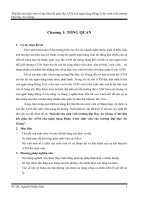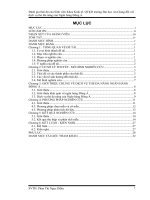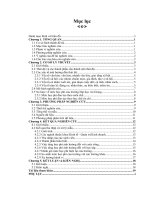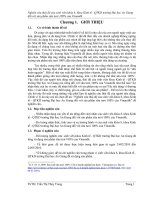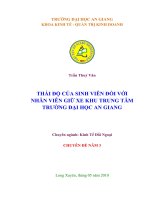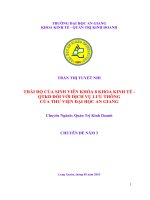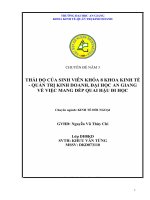Students' attitudes towards cooperative learning at Nghe An teachers' College and Implications for teacher Education programs Thái độ của sinh viên trường CĐSP
Bạn đang xem bản rút gọn của tài liệu. Xem và tải ngay bản đầy đủ của tài liệu tại đây (1.17 MB, 56 trang )
1
VIETNAM NATIONAL UNIVERSITY, HANOI
UNIVERSITY OF LANGUAGES AND INTERNATIONAL STUDIES
FACULTY OF POST-GRADUATE STUDIES
HOÀNG THỊ BÍCH THỦY
STUDENTS’ ATTITUDES TOWARDS COOPERATIVE
LEARNING AT NGHE AN TEACHERS’ COLLEGE AND
IMPLICATIONS FOR TEACHER EDUCATION
PROGRAMS
(Thái độ của sinh viên trường CĐSP Nghệ An về hoạt động học
mang tính hợp tác và các hàm ý cho việc đào tạo
giáo viên)
M.A. MINOR PROGRAMME THESIS
Field: English Teaching Methodology
Code: 60.14.10
HANOI - 2010
2
VIETNAM NATIONAL UNIVERSITY, HANOI
UNIVERSITY OF LANGUAGES AND INTERNATIONAL STUDIES
FACULTY OF POST-GRADUATE STUDIES
HOÀNG THỊ BÍCH THỦY
STUDENTS’ ATTITUDES TOWARDS COOPERATIVE
LEARNING AT NGHE AN TEACHERS’ COLLEGE AND
IMPLICATIONS FOR TEACHER EDUCATION
PROGRAMS
(Thái độ của sinh viên trường CĐSP Nghệ An về hoạt động học
mang tính hợp tác và các hàm ý cho việc đào tạo
giáo viên)
M.A. MINOR PROGRAMME THESIS
Field: English Teaching Methodology
Code: 60.14.10
Supervisor: Lê Văn Canh, M.A
HANOI - 2010
6
TABLE OF CONTENTS
Page
Candidate’s statement i
Acknowledgements ii
Abstract iii
List of Tables vi
List of Abbreviations vii
PART A: INTRODUCTION 1
1. Rationale 1
2. Aims of the study 2
3. Research questions 2
4. Scope of the study 2
5. Research methodology 3
6. Organization of the study
3
PART C: DEVELOPMENT 4
CHAPTER I: LITERATURE REVIEW 4
1.1 Attitudes 4
1.2 Cooperative Learning 5
1.2.1 Definitions of Cooperative Learning 5
1.2.2 Benefits of Cooperative Learning in foreign language learning 7
1.2.3 Review of previous studies related to Cooperative Learning 10
1.2.4 Cooperative Learning and Vietnamese Learning Culture 11
CHAPTER II: THE STUDY 13
2.1 Research questions 13
7
2.2 Participants 13
2.3 Instruments 13
2.3.1 The Questionnaire 14
2.3.2 Follow-up interviews 14
2.4 Data analysis 14
2.5 Results and Discussion 15
2.5.1 Students‟ preferred habits and learning styles 15
2.5.2 Students‟ attitudes and perceptions towards CL 16
2.5.3 Teachers‟ use of CL 19
2.5.4 Students‟ engagement and preferences in CL 24
2.5.5 Students‟ suggestions to improve CL 28
CHAPTER III: IMPLICATIONS AND SUGGESTIONS 30
3.1 Challenges of Cooperative Learning in foreign language learning 30
3.2 Teaching implications 31
3.3 Suggestions 35
PART C: CONCLUSION 38
1. Conclusions 38
2. Limitations of the study and suggestions for further studies 39
REFERENCES 40
APPENDIXES
APPENDIX 1
APPENDIX 2
8
LIST OF ABBREVIATIONS
CL : Cooperative Learning
EFL: English as a foreign language
ESL: English as a second language
9
LIST OF TABLES
Table 2.1. Students‟ preferred learning styles of learning English
Table 2.2: Students‟ attitudes towards CL
Table 2.3: Students‟ perceived benefits of CL
Table 2.4 : Students‟ difficulties in CL
Table 2.5: The frequency of using of CL in and outside classroom
Table 2.6: Teachers‟ ways of assigning students to groups
Table 2.7: The number of students teachers assign to a group
Table 2.8: Students‟ evaluation of teachers‟ way of assigning to a group
Table 2.9: Teachers‟ ways of rewarding groups of students.
Table 2.10: Students‟ evaluation of teachers‟ way of rewarding groups of students
Table 2.11: Group size preferred by students
Table 2.12: Students‟ working in groups
Table 2.13: Students‟ interest in some activities
10
PART A: INTRODUCTION
1. Rationale
Co-operative learning has attracted a great attention in the last few decades for its value
as one of the startegies which help to provide students with more opportunities to learn
from each other. By cooperating with each other in solving learning tasks in the classroom,
the students at the same time create a favourable and active learning atmosphere, thereby
making use of each other‟s resources.
Over the last few decades, Cooperative Learning (CL) has become a popular practice in
both mainstream education and in second/ foreign language education. There has been
empirical evidence to justify the effectiveness of CL in promoting mastery of knowledge
and skills among students of various abilities and ages. Regarding second/foreign language
learning, students, through cooperation, become more actively involved in their lessons
and thus, they have more chance to use the target language than they are in the whole class
arrangement.
Despite its documented benefits, CL has not been adequately researched in Vietnamese
educational settings. So, one of the unresolved questions is to what extent the contextual
variables such as students‟ social background and learning culture affects the success of
CL. For instance, it is not clear whether CL can bring about similar success in the context
where students come from remote rural areas and are taught largely with traditional
methods as it does in other, especially in Western, contexts. This question motivates me to
undertake this study, which aims to explore the possibility of applying the principles and
techniques of CL in a Junior Teachers‟ Training College in one central province of
Vietnam. The focus of my study is to find out the college students‟s attitudes toward CL in
the classroom.
2. Aims of the study
This study sets out to achieve the following aims:
11
● to know the degree to which teachers use CL in their classroom through
students‟ self-reports.
● to investigate into college students‟ attitudes and perceptions toward CL.
It is hoped that the result of the study will inform teachers, first of all those working in
the college, of the possibilities for using cooperative techniques in their teaching. I believe
that any innovative teaching strategy or technique the teacher is trying to use is likely to
fail if the students do not have a positive attitude toward it. Therefore, it is critical to
understand the students‟ attitudes before implementing innovation. Another dimension of
the study is to gain insights into how teachers in the College have used CL through
students‟ verbal reports.
3. Research questions
To achieve the aims of the thesis, the following research questions were proposed:
1. What are the English language students‟ preferred learning habits and learning
styles?
2. How do teachers use CL both inside and outside the classroom according to
students‟ self-reports?
3. What are their attitudes towards, and perceptions of, CL as well as their
suggestions for the use of CL?
4. Scope of the study
As it has been stated above, the study is carried out to investigate college students‟
attitudes toward CL, and therefore, it is a survey by nature. It is not intended to examine
the impact of CL on students‟ learning outcomes. Neither is it intended to explore teachers‟
attitudes toward, and perceptions of, CL. The study was carried out within one Junior
Teachers‟ Training College only. This means that no generalisation of the findings is
intended.
5. Research methodology
12
Due to the aim and scope of the study, two research methods are used in the present
study:
● A questionnaire to investigate students‟ attitudes and perceptions towards CL as well as
their preferences. The questionnaire is designed, primarily, to find out what students think
of CL. And how they prefer to have CL activities in their foreign language classes. Data
were analyzed mainly by means of descriptive statistics.
● Follow-up interviews were conducted to get better insights into students‟ attitudes,
perceptions, and preferences.
6. Organization of the thesis
The thesis is structured into 3 parts:
Part A: Introduction, which introduces the rationale, the aims, the scope, the research
methods and the organization of the study.
Part B: Development which consists of 3 chapters:
Chapter I is a Literature Review. In this chapter, a basic theoretical background for the
study is created by reviewing the relevant literature with a focus on Attitudes, and CL
techniques.
Chapter II, The Study, presents the methods and procedures used in the study, which
consists of a survey questionnaire and follow-up interviews. This chapter also includes
Result and Discussion which presents the method of data analysis as well as the results
derived from the data analysis. Results are presented under themes as coded from the data
analysis.
Chapter III, Implications and Suggestions, presents some suggestions on how to apply CL
techniques in the classroom to achieve better impact.
Part C: Conclusion, summarises the main remarks of the study and suggest some ideas for
further study. Limitations of the study will also be acknowledged in this chapter.
13
PART B: DEVELOPMENT
CHAPTER I: LITERATURE REVIEW
This chapter reviews the literature on CL. In the first place, a definition of „attitude‟ is
provided. This will be followed by a discussion of the nature of CL as well as its
advantages in foreign language learning. Finally, previous studies on CL will be reviewed
to identify a research niche for the present study.
1.1 Attitudes
In general understanding, attitudes are defined as a disposition or tendency to respond
positively or negatively towards a certain thing such as an idea, object, person or situation.
This is often referred to as attitude object, but in the scale of my study, attitude is
understood as „learning attitude‟. The construct of „Attitude‟ has long been considered as
one of the affective variables beside motivation in the realm of language learning as well,
(e.g., Gardner and Lambert 1972).
According to Oxford and Shearin (1994), attitude is one of the factors impacting
motivation in language learning. Gardner (1985) states that positive attitudes and
motivation are related to success in second language learning.
Holmes (1992) believes that people develop attitudes towards languages, which reflect
their views about those who speak the languages, and the contexts and functions with
which they are associated. He claims that attitudes in the context of language learning are
defined as the way people look at the language, the class and the people, and the culture of
language.
Lambert (1967, cited in Macnamara, 1973: 37) mentions two types of attitudes:
„integrative‟ and „instrumental‟ attitude to language learning. He claims that an integrative
attitude (desire to know and become friendly with speakers of a language) is more likely to
lead to success in learning a second language than an instrumental attitude (desire to better
oneself materially by means of the language).
14
Chamber (1999) asserts that learning occurs more easily, when the learner has a
positive attitude towards the language and learning. Positive attitudes on the part of the
language learners can enhance an integrative motivation, and attitudes upon success in
language learning is widely acknowledged Gardner and Lambert (1972) in their extensive
studies give evidence that positive attitudes towards language enhance proficiency as well.
Also, Holme (1992) states that if people feel positive towards those who use the language,
they would be more highly motivated towards learning it.
Unquestionably, good learners are those that have a positive attitude towards their
subject. The overall findings show that positive attitudes have a strong impact on the
success of language learning. Most of the researches have claimed that students‟ attitude is
an integral part of learning and that it should, therefore, become an essential component of
second language pedagogy. There are many educational factors affecting students‟ positive
attitude, such as teacher-student relationships, a positive psychological classroom
atmosphere, or the use of authentic teaching materials and activities. Probably, one of the
best method to help students develop their positive attitudes towards learning English as a
foreign language should be the CL techniques since these techniques help to develop
positive student-teacher attitudes, create a cooperative community of practice, and bring
about helpful, harmonic atmosphere in classroom.
In the present study, the definition by Gardner and Lambert (1972) is adopted,
according to which attitude is “an organised, consistent and habitual manner of thinking,
feeling and reacting to events and persons” (p.148). This is because the definition covers
the meaning of students‟ reactions to CL.
Ajzen and Fishbein (1980) note that attitudes exert a directive influence on behaviour.
An individual‟s attitudes towards something will influence his or her oeverall patterns of
reponses to it. Therefore, before plan is made to apply CL models, it is critical that
students‟ and teachers‟ attitudes towards the intended pedagogical models be investigated.
Moreover, although the benefits of CL have been well documented in the literature, the
students‟ and teachers‟ attitudes to CL models remain scarely researched.
15
1.2 CL
1.2.1 Definitions of CL
There are different perspectives and approaches in the development of CL. However,
there are also many similarities among different CL approaches that is categorized as CL.
Olsen and Kagan (1992) define CL as “a group learning activities organized so that
learning is dependent on the socially structured exchange of information between learners
in groups and in which each learner is held accountable for his or her own learning and is
motivated to increase the learning of others”.
CL is the instructional use of small groups working on specific tasks so that students
enhance not only the individual learning but also the whole group learning (Johnson et al,
2003). Also, Brown and Thomson (2000) define CL as “… a teaching approach that
organizes classroom activity by arranging students in small groups so that they can support
each other‟s learning” (p. 105). CL shares the idea that students working together to learn
are responsible for their teammates‟ learning as well as their own (Slavin, 1990). This view
echos the way Davidson (1990) describes, CL as the task for group completion, discussion,
and (if possible) resolution. It is required to create an atmosphere of cooperation and
mutual helpfulness within each group, so that students work together to maximize their
own and each other‟s learning. Such a view is included in Jacobs et al.‟s (1997) definition
that CL involves concepts and techniques used with a view to maximizing students‟
cooperation for mutual benefits. Thus, a student seeks an outcome that is beneficial to both
himself and all other teammates.
According to Calderon (1987), CL can be defined as “a strategies for the classroom
that is used to increase motivation and retention, to help students develop a positive image
of self and others, to provide a vehicle for critical thinking and problem solving, and to
encourage collaborative social skills”(cited in Christison (1994: 140). In CL situation,
students are motivated to use the language more extensively and they can develop their
language proficiency.
16
Currently, CL is perceived as a generic term for a number of instructional techniques
and procedures that address conceptual learning and social development. Johnson, Johnson
& Stanne (2000) define CL as a general term for an instructional approach that
“emphasizes the conceptual learning and the development of social skills as learners work
together in small heterogeneous group”, it is governed by “the principles of positive
interdependence, individual accountability, face-to-face promoting interaction and group
processing”. In other words, CL is not simply assigning students to groups in which one
student does all the work or team members perform their tasks individually (Kagan, 1994).
Slavin (1982) defines CL as instructional methods in which students of all levels of
performance work together in small groups toward a common goal which encompasses
instructional techniques such as Student Team-Achievement Divisions (STAD), Team-
Game-Tournaments (TGT), Team-Assisted Individualization (TAI), Cooperative
Integrated Reading and Composition (CIRC), Jigsaw, Learning Together, and Group
Investigation (GI). This perspective on CL is adopted as a framework for this study.
The central tenet of CL, according to all above-cited definitions is the idea that students
work in small groups, taking the responsibility for their own learning, thereby helping one
another in their groups to achieve their goals.
1.2.2 Benefits of CL in foreign language learning
CL has long been proven to be effective in improving the overall climate of the
classroom. In addition, CL increases interaction opportunities among learners and
promoted autonomous learning (Thomson, 1998). According to Long & Poster (1985), CL,
like other group work, creates a more positive affective climate into classroom, while it
also individualizes instruction and raises students‟ motivation. Therefore, CL is gaining the
major priority in language learning classrooms over individual learning. As such Johnson
et al. (1998) maintain that CL accommodates the tenets of the theories of cognitive-
developmental, behavioral, and social interdependence. Johnson and Johnson (1994) assert
that CL includes a variety of strategies that utilize students‟ collaboration to maximize
interaction among students according to the principles of positive interdependence,
individual accountability, group processing, and equal opportunity for class participation.
Positive interdependence exists when students come to perceive that their group mates
17
succeed and/or that they must coordinate their efforts with the efforts of others in the group
to complete a task. Learners in CL usually take individual quizzes to demonstrate
individual accountability and personal achievement in order to control for any potential
free ride effect on the efforts of others. Furthermore, learners in CL may also get equal
opportunities to demonstrate their learning. For instance, learners may receive instruction
in reading an official letter; next, they sit in groups and read the letter to complete the tasks
that follow. Then they may individually assume responsibility for performing the tasks.
Benefits of CL, which are discussed subsequently, are out of question.
In terms of academic achievements, CL produces greater student achievement than
traditional learning methodologies. Slavin (1984, cited in Andrew, 10.1.94)) found that
63% of the CL groups analyzed had an increase in achievement. In traditional group work,
students sit together and sometimes work together. This leads to unequal contribution and
participation among students because one or two better students may dominate the others.
This kind of group work does not create interdependence and accountability among
learners. CL methods attempt to structure group activities so as to increase students‟
responsibility and encourage group member to actively participate, improve motivation
and contribute to the atmosphere of cooperation in the class. As a result, CL helps to gain
academic achievements in a quickly way.
Affectionately, CL enhances students‟ self-esteem which in turn motivate students to
participate in the learning process (Johnson & Johnson, 1989). Also, Slavin (1990) says
that one of the most important psychological outcomes of CL is their effect on students‟
self-esteem. Students believe that they are valuable, important and productive individuals,
thus making confident decisions. Students help each other and by doing so, they can build
a supportive community which raises the performance level of each member (Kagan,
1986). Students share their success with their groups, which enhances both the individual‟s
and group‟s self-esteem.
CL helps not only to increase students‟ self-esteem, but also reduces students‟ anxiety
(Oxford, 1990, 1997). In a traditional classroom, fear of failing is a constant thread to each
student. The reason for this is that any mistakes or incorrect answers become to subject to
scrutiny by the whole class. In contrast, in CL situation, students have an opportunity to try
18
out their contributions with each other before presenting it to the whole class. They have
time to think, opportunities to rehearse and respond the answers, thus it enhances the
greater likelihood of success. This helps reduce anxiety in the language learning. On the
other hand, CL establishes an atmosphere of cooperation and helping school-wide
(Deutsch, 1975). It creates a positive learning environment for all participants. According
to Kagan (1994), if people are anxious, but allowed to affiliate, their anxiety level is
reduced. Therefore, Oxford (1990) included that CL as a classroom procedure can lower
anxiety in the language classroom. In brief, CL helps to create a relaxing and comfortable
atmosphere in the classroom, and as a result, the self-esteeme is strengthened. This is
because CL creates a strong social support system in which learners feel respected and
connected to one another (Cohen & Willis, 1985).
What‟s more, CL helps to develop students‟ thinking skills and social skills. CL
develops higher level thinking skills (Webb, 1982). In CL, students tend to participate
more frequently, instead of passively listening to the teacher. It gives students chances to
work together so as to represent the most effective form of interaction (Schwartz, Black,
Strange, 1991). CL also fosters the development of high level reasoning and problem
solving skills (Sharan & Sharan, 1976). The self-learning in groups requires students to
“grasp information, examine it, evaluate it for soundness, and apply it appropriately”
(Johnson & Johnson, 1987, p.36). While working together to accomplish a task, group
members need to formulate their ideas, discuss them, make decisions, defend positions and
resolve differences of opinion, and solve problems. Hence, CL enables students to develop
their critical thinking.
By getting envolved in CL, students also develop their social skills simply because one
of the requirements of CL is the skills and attitudes to work in teams. Thus, CL gives
students a chance to develop the interpersonal skills needed to succeed at school, work, and
within the community. Students work with classmates who have different learning skills,
cultural background, and personalities. Therefore, they are able to understand their
differences and to learn how to deal with conflicts and interact with others. Training
students in dealing with conflicts is a major component of learning training (Aronson
1978; Slavin 1987). Moreover, CL fosters students‟ interaction at all levels (Webb 1982).
19
Both students of high ability work and students of lower ability can understand their
differences and learn how to capitalize on them rather than use them as a basis for
antagonism through warm-up and group building activities. According to Kessler and
MaCleod (1985) “CL promotes positive societal responses …. reduces violence in any
setting …. eliminates fear and blame, and increases honor, friendliness, and consensus.” (p.
219). In reality, CL has helped to improve students‟ social skills.
In short, CL approaches play a vital role in language acquisition. CL brings about many
benefits: academic achievement, self-esteem, development of higher order thinking,
development of social skills. The positive effects from the cooperation make CL one of the
most valuable instructional tools for educators.
1.2.3 Review of previous studies related to CL
CL mode has been applied to maximize student learning through student-student
interaction rather than direct teacher-student interaction (Ilola, Power & Jacobs, 1989).
However, little has been explored about CL.
Johnson and Johnson (1987) compare three different types of learning: CL, Individual
Learning and Comparative Learning. In each kind of learning, their nature and appropriate
use and the skills students need to implement those kinds of learning were referred. Also,
they emphasize the student acquisition of collaborative skills and how the teachers teach
students those skills. Finally, they drew out some teacher‟s concerns about classroom
management in CL.
Hollingsworth et al. (2007) and Al Haidari (2006) point out that CL as a method of
teaching turns out to be a valuable tool to help students learn comprehension strategies
while encouraging positive interactions among peers. The students achieve academic
success by increasing their reading levels and knowledge of comprehension skills, and
there is also an increase in enthusiasm and motivation towards reading. CL is a way to
have students work together to better comprehend what they are reading. What matter in
these activities is that students should have the desire to communicate and to replicate real
communication.
20
Jalilifar (2010) warns that simply putting students in groups does not guarantee positive
results. “Central components of effective CL must be in place so that students can come to
feel that they are positive contributors, not only to their teams, but to the class as a whole”
(p. 104).
Slavin (1990) states that CL may yield different benefits including students‟ self-
esteem, more time-on-task and classroom behavior, a positive attitude toward the class and
class members. He also initiates some forms of CL such as STAD (Student Teams
Achievement Division), TGT (Teams-Games-Touraments), Group investigation, and
Jigsaw.
Chamot and O‟Malley (1987) maintain that small cooperative students groups working
on a task can practice language skills which are directly pertinent to the task. Jalilifar
(2010) examines the effect of CL techniques on college students‟ reading comprehension
by conducting an experimental study with 90 female Iranian college students divided into
three homogenous groups. The results showed that CL techniques helped to improve
students‟ reading achievement. The results suports what Ghaith (2003), Myer (2006),
Tracey and Barbara (2003), and Wilson (1991) found about the positive effect of CL on
students‟ L2 reading comprehension. Jalilifar (2010) concludes that
Group work, pair work, and peer work in CL are common terms that are heard
frequently in ESL/EFL circles. Actually they have occupied a certain amount of
space in communicative language teaching coursebooks. In teacher training
programmes, novice teachers are advised to inject cooperation into their teaching
as skillfully and artistically as possible, but every technique becomes effective if
the realities of the classroom and the cultural background of the target country are
considered. (p. 107)
1.2.4 CL and Vietnamese Learning Culture
It is claimed that Vietnamese students prefer working individually even when they are
put in groups. They tend to compete with one another. Johnson and Johnson (1999)
describes this classroom practice as an individualistic structure, which places great
emphasis on individual students working alone toward the goal independently of other
21
students. Due to the influence of traditional Confucian philosophy, students believe that
knowledge comes from the teacher, not from their peers. As a result, they are reluctant to
accept group members as their collaborators, let alone tutors. They do not appreciate peer
correction and peer rating, which are essential aspects of interdependence in CL (Luu
TrongTuan, 2010).
Vietnamese learners are concerned with the consequence of their speech and how it
may be accepted, which also derives from Confucian philosophy, which stresses the
importance of care in words (Scollon, 1999: 18). They try to represent themselves well in
accordance with the “maxims of modesty” (Littlewood, Liu & Yu, 1996: 81), and to avoid
group conflicts, an element honoured by CL in order to help students develop conflict
management skills in group interactions.
Luu Trong Tuan (2010) conducted an experimental study with 77 first-year EFL
students in a university in Ho Chi Minh City. Findings showed that in the first few weeks
of the experiment, the students were resistant to CL, but later on they became more
positive toward this approach to learning. By the end of the course, a majority of the
students reported that CL helped them understand the course materials better. The
achievement test result also showed that the experiemental students scored higher than
those in the control group.
This literature review shows a wide gap of research on CL in Vietnamese contexts,
both in the secondary school and college or university settings. This study, therefore, is an
attempt to make a modest contribution to this research gap.
Summary
In this chapter, I have reviewed the literature on CL which includes the major features
and the benefits of CL in language classroom. As it is revealed in this literature review,
very little has been done to investigate students‟ attitudes toward CL. I believe that
people‟s behaviours are shaped by their attitudes. As a result, investigating students‟
attitudes should be the first step toward the application of CL strategies in the real
classroom. This is the motive of the present study. The next chapter will present the
research methods which were employed in this study.
22
CHAPTER II: THE STUDY
In this chapter I will describe the present study. First I will present the methods and
procedure used in the study to find out the students‟ attitudes towards CL at Nghe An
Teacher‟s College, which include a survey questionnaire administered to the students and
follow-up interviews. Then the results of the study will be presented and discussed.
2.1 Research questions
As stated above, this study was designed to seek the answers to the following
questions:
1. What are the English language students‟ preferred learning habits and learning
styles?
2. How do teachers use CL both inside and outside the classroom according to
students‟ self-reports?
3. What are their attitudes towards, and perceptions of, CL as well as their
suggestions for the use of CL?
The answer to these questions would serve to give some insights into college student‟s
attitudes towards CL as well as their preferences for CL activities in language classroom.
2. 2 Participants
Participants in this study were 83 second year English major students, aged from 18 to
21 at Nghe An Teachers‟ College. They had learnt English for nearly 5 years or more, 3
years at secondary school and nearly two years at the English Department of the College.
All of them come from the countryside. At the time of the study, they were in the second
semester of the second year of the three-year teacher training programme. These students
will become lower secondary school teachers of English upon their graduation.
2. 3 Instruments
To obtain data for the study, two different instruments were employed: a survey
questionnaire and follow-up interviews.
23
2. 3.1 The Questionnaire:
A 20-item questionnaire was administered to 83 students from three different classes.
All questions were written in Vietnamese to guarantee students‟ accurate understanding as
well as their full confidence in their responses (see Appendix 1).
The questions focus on the following categories:
● Students‟ preferred habits and learning styles of learning English (Q1)
● Students‟ attitudes towards CL (Q2, Q3, Q4, Q5, Q6)
● Students‟ perceptions of benefits of CL (Q7)
● Students‟ perception of difficulties of CL (Q8)
● Students‟ self-reports of teachers‟ use of CL (Q9, Q10, Q11, Q12, Q13, Q14, Q15, Q16)
● Students‟ engagement and preferences in CL (Q17, Q18, Q19)
● Students‟ suggestions to CL (Q20)
2.3.2 Follow-up interviews
The follow-up interviews were conducted after the questionnaire data were initially
analysed. In order to make the interviewees comfortable, all the interviews were conducted
in Vietnamese. Each interview lasted approximately 10 minutes. The interviews were like
informal conversations with the aims of helping the students to easily express their
thoughts about CL in their college. 5 students were selected conveniently. All interview
questions in the interviews are open-ended and aimed at clarifying some issues related to
the questionnaire data (see Appendix 2).
2.4 Data Analysis
The questionnaire data were analysed quantitatively by means of descriptive statistics.
After the questionnaire was returned, responses were categorised and tabulated.The same
method of data collection was employed for the interview data.
2.5 Results and Discussion
All the collected data were then analyzed and discussed as bellows in order to find out
students‟ attitudes toward CL.
24
2.5.1 Students’ preferred habits and learning styles
Question 1 in the Questionnaire asked the students about their preferred learning styles.
It is revealed from their responses that nearly two-thirds of them (61.4 %) reported that
they usually studied independently by themselves. This is against the 21.7% of those
reporting that they usually studied in groups, and 16.9% said that they usually studied with
another who had a similar way of thinking and learning styles. (see Table 2.1 below).
The students’ preferred ways of learning English
No. of
responses
Percent
a. (with others in the group)
18
21.7
b. (with some who share the similar thought and
learning styles)
14
16.9
c. (with no one - studying alone)
51
61.4
Table 2.1. Students’ preferred learning styles of learning English (N=83)
The results from the data analysis showed that the majority of 2
nd
students at Nghe An
Teachers‟ College seemed to prefer a traditional method, i.e learning alone. This learning
style appeared to persist even when they worked at home or outside the classroom. It is
likely that this learning habit was formed by their experiences with the traditional teaching
methods where instruction is largely teacher-fronted and students are expected to take
notes, then do exercises. Learning is assessed individually following a norm-referenced
approach. This way of learning has been critiqued by many scholars (Nguyen, 2002; Oanh,
2006).
2.5.2 Students’ attitudes and perceptions towards CL
2.5.2.1 Students’ attitudes towards CL
Five questions (Question 2, 3, 4, 5 and 6) in the Questionnaire were designed to find
out students‟ attitudes towards CL.
25
Comfort with
group work
(%)
Engagement in
group work
(%)
Perceived need of
group work
(%)
Attitudes towards
group work
(%)
Positive
78.3
62.2
88.0
80.8
Negative
21.7
0.00
0.00
2.4
Neutral
0.00
37.8
12
16.9
Table 2.2: Students’ attitudes towards CL (N=83)
Table 2.2 shows that a large number of the students (78.3%) felt more comfortable and
learned more when they work in groups while only 21.7 % of the students felt so when
they work alone. When asked about perceived need of group work, almost students said
that it is very necessary to organize group work activities. Only 12% of the students felt
not very necessary to do it. Also, the students‟ responses to question 5 showed that most
students have a positive attitude towards group work. More than eighty per cent of the
students said that they were interested in these activities. Obviously, group work could
increase students‟ interest in the lesson when most students found group work activities
necessary and interesting, so that 62.2% of them enthusiastically participate in group-work.
However, the number of the students (37.8%) is not very active in participation.
It is clear from the above data analysis, the numbers of the students who have positive
attitudes toward CL far more outweighs the number of the students who have negative
attitudes. In other words, these students appeared to be more favour of CL. Furthermore,
most of the students tended to be enthusiastic about group-work although a rather large
number of the students still keep silent and contribute very little to their group-work. It can
be interpreted that although CL is perceived as being beneficial to most of the students,
there are students who were not aware of the benefits of CL. This is understandable
because students differ in their learning styles, and not all of them perceive of a particular
classroom activity or teaching style in the same way (O‟Malley & Chamot, 1990).
2.5.2.2 Students’ perceived benefits of CL
26
Question 7 in the Questionnaire asked the students about their perceptions of the
benefits of CL. In this questions, 8 different benefits of CL, which are adapted from the
literature about CL, are listed and the students chose whatever that they agreed with (see
Table 2.3).
Benefits
No. of mentions
Group work helps……
1. gain better academic achievements
2. enhance self-esteem
3. develop critical thinking skills
4. develop social skills
5. lower anxiety
6. provide more opportunities for communication in English
7. provide more opportunities for learning from peers
8. create a relaxing and friendly learning environment
31
36
48
34
46
41
69
52
Table 2.3: Students’ perceived benefits of CL (N=83)
As shown from Table 2.3, more than half of the students responding to the
questionnaire agreed that CL provided more opportunities for them to learn from their
peers (N=69) and created a relaxing and friendly learning environment (N=52). In addition,
nearly half of them (N=46) thought that CL helped to reduce their anxiety so that they felt
more confident in participating in learning activities. More opportunities for developing
their critical thinking skills and practicing communication in English were two other
benefits which were opted for by respectively 48 and 41 out of 83 respondents while
approximately half of them (N=48) felt that their critical thinking skills could be developed
through CL. This supports Webb‟s (1982) claims about the benefits of CL. However, only
about one-third or 31 of the respondents thought that CL helped them to gain better
academic achievements. Similarly, almost the same number agreed that CL helped to
develop their social skills (N=34) or enhance their self-esteem (N=36). This implies that
students are well aware of getting more benefits from CL and in fact, CL is really
beneficial to the students of learning English. They thought CL helped to create a relaxing
27
atmosphere which lowers their anxiety (Oxford, 1997). As the result, the question set out
for both teachers and students here is how to make all students get more and more benefits
from CL because CL has been proved to be very useful in learning English in general, and
in developing the students‟ communicative competence, which is considered to be the final
target of teaching and learning English.
2.5.2.3 Students’ difficulties in CL
Options
No. of students
Conflict in groups
68
Reluctant attitudes of some students in groups
36
More frequent use of the mother tongue because of poor ability of
English
56
Loss of concentration because of noisy class
9
Difficulties in exchange information because of physical classroom
arrangement
0
Lack of time
32
Lack of the help from the teachers
15
Table 2.4: Students’ difficulties in CL (N=83)
The figures provided in Table 2.4 reveal the difficulties that students reported to have
encountered when they worked in groups. The most serious problem to the students was a
conflict occurring within the groups (N=68). Fifty-six students reported the dominance of
the mother tongue by group members in group discussions. In addition, they reported that
reasons that accounted for their failure in group work include lack of time (N= 32), the
unwillingness of some students (N=36), lack of the help from their teachers (N=15). This
supports Brown‟s (2001) idea that CL may be a challenge to some students because of
personality differences. However, only a small number of the students (N=9) complained
about noisy classes. None of the respondents claimed they had difficulties when they
moved around the classroom to swap information with other groups.
28
This information is useful in that it helps teachers who are keen to apply CL in their
classroom to work out strategies to address these issues for the success of CL.
2.5.3 Teachers’ use of CL
Question 9 and 10 in the Questionnaire (Appendix 1) are designed to ask students
about their opinions about frequency of teachers‟ use of CL in language classroom and
outside classroom. Question 11, 12, and 13 refer to teacher‟s ways of assigning students to
groups. Question 14 refers to teacher‟s way of rewarding groups of students. In order to
ask the students to evaluate their teachers‟ application of CL activities in language
classroom, two questions (Q15 and 16) were designed in the Questionnaire.
3.5.3.1. The frequency of using of CL inside and outside classroom
Teachers’ use of CL
Often
(%)
Sometimes
(%)
Rarely
(%)
Never
(%)
Teachers‟ use of CL inside classroom
48.2
51.8
0
0
Teachers‟ use of CL outside classroom
12.0
67.5
10.8
9.6
Table 2.5: The frequency of using of CL inside and outside classroom (N=83)
When asked about the teachers‟ frequency of using CL activities inside and outside
classroom, 48.2 % of the students said that their teacher often used CL activities in
language classroom while 51.8 % of them said that their teachers sometimes used them.
It is noticeable that only 12.0 % of the students reported that their teacher often used
CL activities outside classroom. More than half of the respondents (67.5 %) said that their
teachers sometimes used these activities, whereas 10.8 % and 9.6% of them stated that
their teachers rarely or never used those activities respectively.
It is obvious that CL activities were not used so often in English classes at Nghe An
Teacher‟s College, while they were rarely used outside the classroom. It can be inferred
from this information that CL has not been very popular in the College. Individual work
